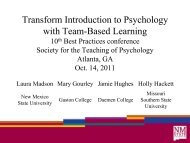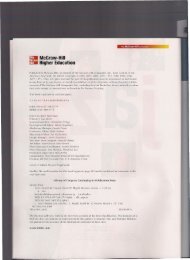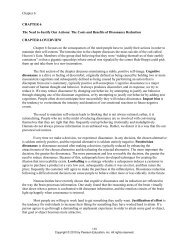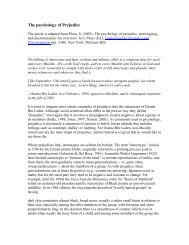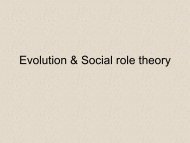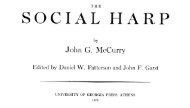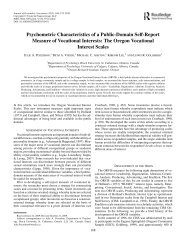Attitudes and Attitude Change CHAPTER 7 Attitudes and Attitude ...
Attitudes and Attitude Change CHAPTER 7 Attitudes and Attitude ...
Attitudes and Attitude Change CHAPTER 7 Attitudes and Attitude ...
Create successful ePaper yourself
Turn your PDF publications into a flip-book with our unique Google optimized e-Paper software.
174<br />
Copyright © 2010 by Pearson Education, inc. All rights reserved.<br />
<strong><strong>Attitude</strong>s</strong> <strong>and</strong> <strong>Attitude</strong> <strong>Change</strong><br />
6. Describe the Yale <strong>Attitude</strong> <strong>Change</strong> approach. Identify <strong>and</strong> define the three factors in an influence<br />
setting emphasized by this approach. Provide examples of each factor. Identify a problem with<br />
the Yale <strong>Attitude</strong> <strong>Change</strong> Approach. (p. 184)<br />
7. Describe the aim of attitude change models like Petty <strong>and</strong> Cacioppo’s elaboration likelihood<br />
model <strong>and</strong> Chaiken’s heuristic-systematic model of persuasion. (p. 185 & 191)<br />
8. Identify the two routes to persuasion described in the elaboration likelihood model. Identify the<br />
factors that determine the route people take. Identify factors that increase people’s motivation <strong>and</strong><br />
ability to pay attention to the arguments. Discuss how attitudes changed by the central route to<br />
persuasion differ from attitudes changed by the peripheral route. (pp. 184-185 & 189)<br />
9. Discuss the influence of emotion on persuasion. Identify the role of fear-arousing<br />
communications in persuasion. Describe the conditions under which fear appeals foster or inhibit<br />
attitude change. (pp. 189-191)<br />
10. Describe the process whereby emotions act as heuristics to persuasion according to the heuristicsystematic<br />
model of persuasion. Identify the problem with using emotions as a guide to attitude<br />
formation. (p. 191)<br />
11. Identify the most effective means of changing affectively <strong>and</strong> cognitively based attitudes. (p. 192)<br />
12. Discuss cross-cultural differences in the kinds of attitudes people have <strong>and</strong> how these attitudes are<br />
changed. (p. 193)<br />
13. Identify the purpose of attitude inoculation. Describe product placement <strong>and</strong> what makes it<br />
effective. Discuss how attitude inoculation is used to help teens resist peer pressure. Discuss the<br />
role of reactance when persuasion attempts “boomerang.” (pp. 194-197)<br />
14. Describe the conditions under which attitudes predict spontaneous <strong>and</strong> deliberative behaviors.<br />
Discuss the role of attitude accessibility in predicting spontaneous behaviors. (pp. 197-198)<br />
15. Discuss the role of people’s intentions <strong>and</strong> other variables outlined in the theory of planned<br />
behavior in predicting deliberative behaviors. Define <strong>and</strong> explain the relationship between<br />
attitudes toward behaviors, subjective norms, <strong>and</strong> perceived behavioral control that is outlined in<br />
the theory of planned behavior. (pp. 198-199)<br />
16. Identify the most effective advertising strategies for changing affectively <strong>and</strong> cognitively based<br />
attitudes when personal relevance is high, for changing cognitively based attitudes when personal<br />
relevance is low, <strong>and</strong> for selling bl<strong>and</strong> products that evoke few emotions. (pp. 200-202)<br />
17. Discuss the controversial topic of subliminal advertising <strong>and</strong> evaluate the claim that subliminal<br />
messages are effective. Describe evidence for subliminal influence from laboratory experiments.<br />
Identify what research has found regarding the power of advertising that is consciously perceived.<br />
(pp. 202-204)<br />
18. Discuss how advertising transmits information regarding cultural stereotypes. (pp. 204-205)






